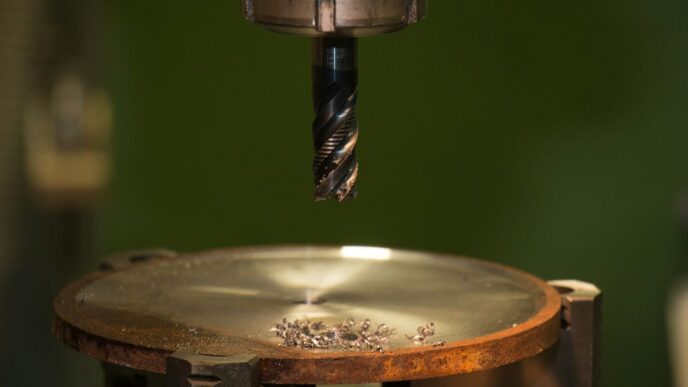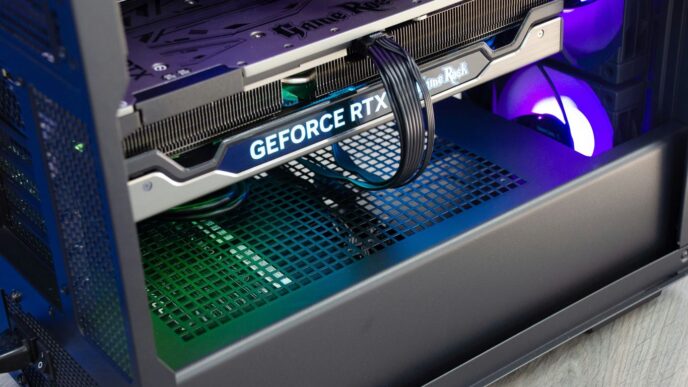The world of computer chips is changing fast, and a big part of that is photonics. Basically, instead of just using electricity, these chips use light to move data around. This means things can get a lot faster and use less power. In 2025, several photonic chip manufacturers are really pushing the boundaries. They’re working on everything from making internet connections super speedy to developing new ways to build chips that could power future AI. It’s a pretty exciting time to see what these companies come up with.
Key Takeaways
- Companies like Cisco and Intel are making big strides in high-speed connections, using photonics to send data faster than ever before.
- Lumentum Holdings is growing its product range, often by acquiring other companies, to offer more solutions for data centers and other tech areas.
- New players are emerging, focusing on specific needs like AI data centers with laser-integrated photonics, showing how specialized the field is becoming.
- The way chips are designed and made is changing, with a focus on combining electronics and photonics, and using new materials for better performance.
- Foundries and equipment makers are crucial for producing these advanced photonic chips, developing the tools and processes needed for precise manufacturing.
Leading Photonic Chip Manufacturers Driving Next-Generation Technology
The world of technology is always moving, and in 2025, a few companies are really pushing the boundaries in photonic chips. These aren’t just small players; they’re giants in the field, making big waves that will affect how we connect and process information for years to come. Think faster internet, smarter data centers, and even new ways to do computing. It’s pretty exciting stuff, honestly.
Cisco Systems: Pioneering High-Speed Interconnects
Cisco is a name most people know for networking gear, but they’re also doing some really important work with photonic chips. They’re focused on making the connections between different parts of our digital world super fast and efficient. This is especially important for data centers, which are basically the brains of the internet. As data keeps growing, these high-speed interconnects are becoming more and more critical. Cisco is working on solutions that can handle massive amounts of data, making sure everything runs smoothly without slowdowns. They’re looking at speeds that were hard to imagine just a few years ago, and it’s all about keeping up with the demand for more bandwidth.
Intel Corporation: Advancing Silicon Photonics Integration
Intel is another big player that’s really leaning into silicon photonics. What’s cool about this is that they’re trying to build optical components right onto silicon chips, similar to how they make regular computer processors. This could make things much cheaper and easier to produce in large quantities. Intel’s work in this area is key to enabling the massive bandwidth growth needed for future data centers and the rollout of 5G networks. They’re developing chips that can move data at incredibly high speeds, like 400 gigabits per second and even faster, all in smaller packages. This integration means optical technology can become more widespread and accessible.
Lumentum Holdings: Expanding Product Offerings Through Strategic Acquisitions
Lumentum is making some smart moves, especially through buying other companies. They’ve got a wide range of photonic products, from transceivers to diodes. A big step for them was acquiring Cloud Light Technology Limited. This added some really advanced optical modules, particularly for things like automotive sensors and connecting data centers. It’s a smart way for Lumentum to grow its product line quickly and meet the increasing needs of AI infrastructure and data centers. They’re basically building out a more complete toolkit for the future of high-speed communication.
Innovations in Photonic Chip Design and Fabrication

This section looks at how companies are getting creative with designing and making photonic chips. It’s not just about making them smaller, but also about making them work better and fit into new kinds of technology.
IBM Corporation: Expertise in Optical Interconnects for Board-Level Applications
IBM is doing some neat work with optical connections that can go right onto circuit boards. Think about how much faster data could move if we didn’t have to rely solely on electrical wires. They’re figuring out how to make these optical links more practical for everyday electronics, which could really speed things up for computers and servers. It’s all about making those connections more direct and efficient.
NeoPhotonics Corporation: Developing Ultra-Pure Light Lasers and Optoelectronic Products
NeoPhotonics is focusing on making really clean, pure light sources, which are lasers. This pure light is super important for sending data over fiber optic cables without losing much signal. They’re also working on other light-based electronic parts. Their work is key for building faster and more reliable communication networks. Having these high-quality components means less noise and better performance.
Hamamatsu Photonics: Contributions to Laser and Optoelectronic Technologies
Hamamatsu Photonics has a long history of making good laser and light-sensing equipment. They’re involved in a lot of different areas, from scientific research tools to industrial applications. Their contributions help advance the whole field of photonics by providing reliable and advanced devices that others can build upon. It’s like they’re providing the building blocks for many new photonic technologies.
Emerging Players in the Photonic Chip Landscape
The world of photonic chips isn’t just about the big names anymore. There are some really interesting smaller companies popping up, doing some pretty cool stuff that could change how we use technology, especially for things like AI and super-fast computing. It’s exciting to see these newer players shaking things up.
Scintil Photonics: Laser-Integrated Photonics for AI Data Centers
Scintil Photonics is a fabless company that’s really focused on making AI data centers work better. They’ve developed this thing called SHIP™ process technology, which basically lets them put lasers right onto their photonics chips. This is a big deal because it means they can create optical connections that are super fast and don’t have much delay. Their LEAF Light™ chip is pretty impressive; it gives a lot of control over how light signals are handled, allowing for speeds that go way beyond 1 terabit per second. This kind of innovation is exactly what’s needed to handle the massive amounts of data that AI applications churn through. They’re based in Grenoble, France, but have a presence in Canada and the US too.
Cognichip: Revolutionizing Semiconductor Design with AI
Cognichip is tackling a major bottleneck in making new chips: the design process itself. They’ve created something called the Artificial Chip Intelligence (ACI)® platform. Think of it as an AI that understands the physics of chip design. The goal is to drastically cut down the time and effort it takes to design a chip. This is important because software is moving so fast, and chip design needs to keep up. Cognichip is still pretty new, founded in 2024, and they’ve already managed to get some good funding. They’re based in Redwood City, California, and their approach is definitely one to watch in the semiconductor world.
Arago: Advancing Photonic Computing with Recent Funding
Arago is another company making waves in the photonic computing space. They’ve recently secured a good amount of funding, which shows that investors are seeing potential in what they’re doing. Photonic computing uses light instead of electricity to do calculations, and it promises some serious speed and efficiency gains. Arago’s work in this area is helping to push the technology forward. They’ve got a team of 25 people and have attracted investment from some notable venture capital firms. Their progress is a good sign for the future of computing.
Key Technologies and Trends in Photonic Chip Manufacturing
The world of photonic chips is moving fast, and a few big trends are shaping how these tiny marvels get made. It’s not just about making them smaller; it’s about making them smarter, more efficient, and easier to design.
EDA and Photonics Integration for Enhanced Chip Design
Think of Electronic Design Automation (EDA) tools as the sophisticated software architects use to build complex circuits. Now, imagine merging those tools with the principles of photonics – how light behaves. This combination is a game-changer. Companies are working on ways to use EDA to design photonic integrated circuits (PICs) more easily. This integration helps create chips that can move data much faster and use less power, which is exactly what we need for things like super-fast data centers and the next generation of communication networks. It’s all about making the design process smoother and the resulting chips more capable.
Fabless Chip Design Evolution for Specialized Applications
The
Foundries and Equipment Manufacturers Enabling Photonic Chip Production
When we talk about making these fancy photonic chips, it’s not just about the design itself. You need the right factories, the foundries, and the machines to actually build them. Think of it like baking a cake – you can have the best recipe, but without an oven and the right pans, you’re not getting anywhere.
Foundry Advancements for High-Performance Chip Manufacturing
Foundries are really stepping up their game. Companies like Lightium, for instance, are using this cool Thin-Film Lithium Niobate (TFLN) tech. It’s all about making data move super fast and without using a ton of power, which is a big deal for AI and data centers. They’re working on 200mm wafers, trying to get these chips out the door quicker and with less risk for their customers. We’re talking modulation speeds over 100 GHz here – pretty wild stuff. These foundries are the backbone for scaling up production of advanced photonic components. It’s not just about making more chips, but making better ones that can handle the increasing demands of modern tech.
Equipment and Tooling Innovations for Precision Production
Then there are the companies making the actual tools. It’s a bit like needing specialized wrenches for a specific car engine. Companies like Inversion Semiconductor and Lace Lithography are developing new machines for things like lithography and deposition. These aren’t your grandpa’s chip-making machines; they’re designed for the super-tiny, precise work needed for smaller and more efficient chips. The goal is to make the manufacturing process itself more efficient and, importantly, more eco-friendly. It’s a constant race to build equipment that can handle the next generation of chip designs.
OSAT and Sensor Technology Developments for Enhanced Testing
Once the chips are made, they need to be put together and tested. That’s where Outsourced Semiconductor Assembly and Test (OSAT) services come in. Companies like Quantum Diamonds and Phlux Technology are adding advanced sensors to this process. Why does this matter? It means better accuracy and efficiency when they’re testing and packaging the chips. This leads to fewer duds and more reliable chips coming off the line. It’s a critical step that ensures the quality of the final product, especially for sensitive applications like LiDAR.
Integrated Device Manufacturers Shaping the Photonic Chip Ecosystem

Integrated Device Manufacturers, or IDMs, are really important for bringing new photonic tech into the real world. They’re not just designing chips; they’re also making them, which gives them a lot of control over how things turn out. This means they can connect the dots between the lab bench and the products we actually use.
IDM Strategies for Hybrid Manufacturing Models
IDMs are getting pretty clever about how they make things. Instead of doing absolutely everything themselves, many are adopting hybrid manufacturing. This means they might handle the really tricky, high-value parts of the process in-house, like the core photonic integration or specialized testing. But for other, more standard steps, they’ll team up with external foundries or specialized manufacturers. It’s like a chef using some pre-made ingredients to save time, but still cooking the main dish from scratch. This approach helps them stay flexible and get products out faster without sacrificing quality on the critical bits.
Seamless Integration of Quantum Capabilities into Mainstream Applications
One of the most exciting areas IDMs are working on is bringing quantum technology into everyday tech. Think about it – quantum computing is still pretty niche, but IDMs are figuring out how to weave its power into existing systems. This isn’t about building entirely new quantum computers for everyone tomorrow. Instead, it’s about finding ways to use quantum principles for specific tasks that current computers struggle with, maybe in areas like advanced materials science or complex simulations. They’re aiming to make quantum advantages accessible without requiring a complete overhaul of current infrastructure. It’s a slow but steady process, focusing on practical applications that can be built upon existing semiconductor foundations.
Focus on Sustainability and Energy Efficiency in Production
There’s a growing push for greener manufacturing, and IDMs are definitely paying attention. Making chips, especially advanced ones, uses a lot of energy and resources. So, IDMs are looking at ways to cut down on waste and power consumption. This could mean using less water in fabrication plants, finding more energy-efficient ways to run their equipment, or even designing chips that use less power once they’re in use. It’s not just about being environmentally friendly; it’s also about reducing operational costs, which is a win-win. They’re exploring new materials and processes that are less harmful and more efficient, trying to make the whole lifecycle of a photonic chip more sustainable.
Looking Ahead
So, as we wrap up our look at the companies making waves in photonic chips for 2025, it’s clear things are moving fast. We’ve seen how players like Cisco, Intel, and Lumentum are pushing the boundaries with their tech and smart business moves. It’s not just about the big names, though; there are plenty of smaller, innovative companies working on new materials and designs that could really change the game. The focus on making things faster, more efficient, and even more sustainable seems to be the common thread. It’ll be interesting to see how these advancements play out and which companies really hit their stride in the coming years. One thing’s for sure: the world of photonic chips is definitely one to keep an eye on.
Frequently Asked Questions
What exactly are photonic chips and why are they important?
Photonic chips are tiny electronic circuits that use light, or photons, instead of electricity to send and receive information. Think of them like super-fast highways for data. They’re crucial because they can move way more information, much faster, and use less energy than regular chips that rely on electricity. This makes them super important for things like super-fast internet, advanced computers, and even self-driving cars.
Which companies are leading the way in making these new photonic chips?
Several big companies are making waves. Cisco Systems is known for creating connections that let data travel at lightning speeds. Intel Corporation is getting really good at putting these light-based parts right onto regular computer chips, making them more powerful and efficient. Lumentum Holdings is also a major player, constantly adding new and improved products to their lineup.
Are there any newer, smaller companies making a big impact too?
Yes, definitely! Companies like Scintil Photonics are developing special chips with built-in lasers for things like AI data centers, which need to handle massive amounts of data very quickly. Cognichip is using artificial intelligence to completely change how computer chips are designed, making the process faster and smarter. Arago is also pushing the boundaries of computing using light, and they’ve recently received good financial backing to help them do it.
What new technologies are making these photonic chips better?
A lot of cool stuff is happening! Designers are using smarter computer tools that combine electronics and light (called EDA and Photonics Integration) to create better chips. Also, companies that don’t make chips themselves but design them (fabless design) are creating specialized chips for very specific jobs. Plus, scientists are discovering new materials and chemicals that make these chips work even better and last longer.
Who helps make these advanced photonic chips if companies don’t make them themselves?
There are special factories, called foundries, that are getting really good at making these high-performance chips with amazing precision. There are also companies that make the special machines and tools needed for this precise manufacturing. And then there are companies that help test and package the finished chips, making sure they work perfectly.
What’s the future looking like for photonic chips?
The future is bright! We’ll see more companies figuring out how to combine different types of manufacturing to make chips. They’re also working on adding quantum computing abilities into regular chips, which could lead to incredibly powerful computers. A big focus will also be on making the manufacturing process more eco-friendly and using less energy, which is good for the planet and for saving money.














